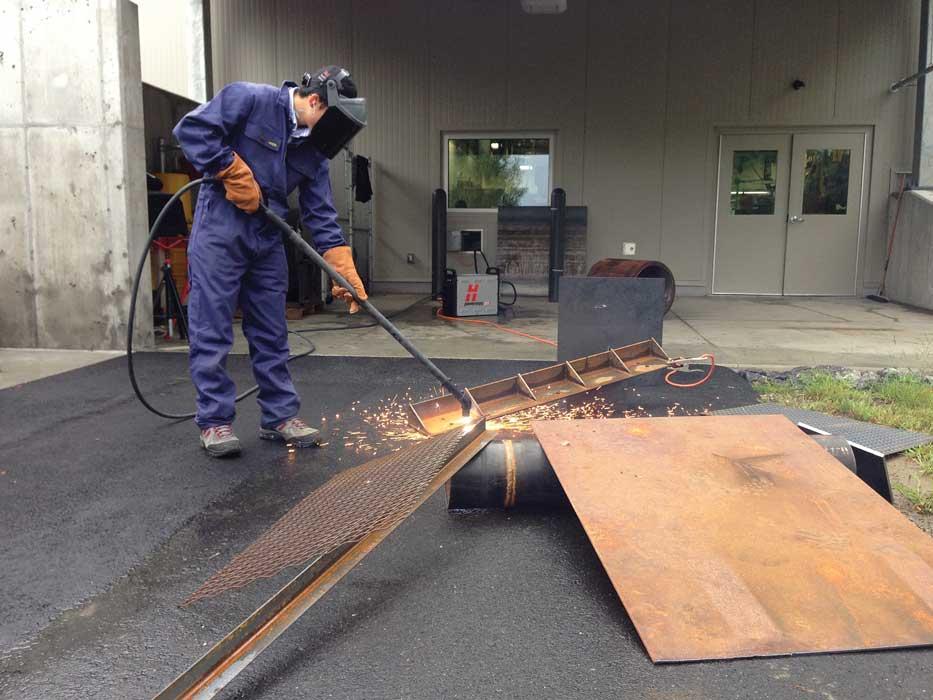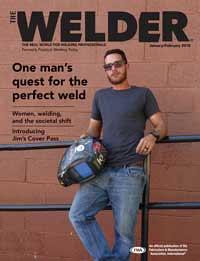Project Manager
- FMA
- The Fabricator
- FABTECH
- Canadian Metalworking
Categories
- Additive Manufacturing
- Aluminum Welding
- Arc Welding
- Assembly and Joining
- Automation and Robotics
- Bending and Forming
- Consumables
- Cutting and Weld Prep
- Electric Vehicles
- En Español
- Finishing
- Hydroforming
- Laser Cutting
- Laser Welding
- Machining
- Manufacturing Software
- Materials Handling
- Metals/Materials
- Oxyfuel Cutting
- Plasma Cutting
- Power Tools
- Punching and Other Holemaking
- Roll Forming
- Safety
- Sawing
- Shearing
- Shop Management
- Testing and Measuring
- Tube and Pipe Fabrication
- Tube and Pipe Production
- Waterjet Cutting
Industry Directory
Webcasts
Podcasts
FAB 40
Advertise
Subscribe
Account Login
Search
Manual plasma cutting and gouging in 2018
New consumable technology makes manual plasma cutting and gouging faster, safer, and more precise
- By Harry Mellott and JoAnn Bortles
- January 19, 2018
- Article
- Cutting and Weld Prep

Figure 1
Figure 1. Consumables that are longer and narrower than traditional consumables provide increased visibility, allowing you to make a more precise cut or gouge.
Today’s air plasma systems have a lot going for them. They are smaller and more portable than ever, consumables last much longer, and they feature all kinds of smart technology to make operation easier and cuts more consistent. Still, you face several challenges when it comes to cutting metal and gouging welds manually. These challenges include cutting metal in a hidden or hard-to-reach area or precisely removing a weld without damaging the surrounding metal. Another challenge is removing temporary attachments, which is difficult to do without a significant amount of grinding.
Fortunately, new advances are helping to overcome these challenges, increasing productivity and decreasing operating cost. Further, these advances are leading to fewer worker injuries and an overall safer work environment.
These advances include:
- Consumables that are longer in length for cutting and gouging.
- Torches with longer handles that enable the operator to cut or gouge from a distance.
- Consumables designed to cut flush to the metal surface.
- Gouging consumables in greater variety, allowing for increased control.
Getting Into a Tight Spot
A common challenge you might face during manual plasma cutting is positioning the hand-held torch into a tight location while still having the ability to see what you are cutting or gouging. Once the torch is in position, you can’t see what you’re doing because both the metal and torch head are obstructing your view.
Consumables that are a few inches longer and narrower than traditional consumables give you greater visibility, which, in turn, allows you to make a more precise cut or gouge (see Figure 1). Both can reduce or even eliminate the amount of grinding necessary.
This consumable design is also helpful when you need to perform close cuts to the web on a beam. It provides increased reach and access, making this type of cutting much easier and more accurate.
Maintaining Distance
At the opposite end of the spectrum are those times when you don’t care so much about precision as you do productivity, safety, and comfort. Whether that includes scrapping applications or cutting metal overhead, hand-held torches now are available with a variety of different head angles and lengths. These torches, which can range from 2 to 6 feet in length, have many ease-of-use and safety benefits that can reduce operating costs.
For example, these long torches are suitable for cutting samples of rolled steel without slowing down the production line, for an array of scrapping applications, and for applications that put you at risk of being struck by falling metal. The longer torch also has helped increase productivity and reduce incidences of injury and fatigue in metal scrapping applications (see Figure 2).
In CNC table cutting applications, the downtime from removing metal skeletons can be costly. Long torches can reduce that downtime when you have to cut the skeleton into small, manageable pieces of scrap to be removed from the table. You can stand on the floor next to the table rather than stand or kneel on the table itself to cut up the skeleton, which reduces ergonomic issues from bending over and eliminates the risk of falling.
Achieving a Flush Finish
In most large fabrication projects, lugs and other attachments need to be removed before you prep the surface for finishing. These typically are removed using oxyfuel, carbon arc gouging, or traditional plasma cutting tools. It can take a lot of time to cut or gouge away the welds that hold these attachments to the base metal and then grind away any residual metal. However, new consumables designed to bend the plasma arc as it exits the torch can help you remove these attachments more quickly and easily.

Figure 2
Figure 2. Long torches have helped increase productivity and reduce incidences of injury and fatigue in metal scrapping applications.
An angled nozzle bore design and flat guiding shield allow you to cut closer to the base metal, usually leaving less than 3⁄16-inch residual material on the base or workpiece. This, in turn, cuts down on the need for grinding and repair work. In addition to time savings and safety benefits, the 45-degree angle of the arc allows for lugs and attachments to be removed with a flat bottom, increasing the chances that the lug or attachment can be reused.
Getting the Right Gouge
When it comes to gouging, the depth and width of a gouge is controlled by adjusting the angle of the torch to the metal, the speed of travel, the amount of arc stretch, and amperage level. For example, a steeper angle and slower forward movement result in a deeper gouge, while a lower angle and faster forward movement result in a more shallow gouge. Sometimes a feathering movement (flicking the torch away and then back to the metal) allows for greater precision as the metal cools for a moment and helps you to “wash away” items like old welds and frozen bolt heads.
The most common technique involves positioning the torch at a 40-degree angle to the work surface while the pilot arc is formed and transferred to the plate. Once contact is made, you aim or feed the arc in the direction you want to gouge. The exact torch placement can be fine-tuned so that the torch is at the best angle and position to wash away the top layer of metal (see Figure 3).
Technique, however, can only get you so far, which is where consumable choice comes in. A wide arc from a gouging nozzle with a larger bore from a plasma system with high-output current will result in a wider gouge as compared to an arc from a nozzle with a smaller bore from a plasma system with low-output current.
Today, gouging consumables are available that allow for aggressive metal removal for deep gouge profiles and extreme metal washing applications; for more controlled metal removal, ideal for achieving shallow gouge profiles or for light material washing applications; and for precise removal of small amounts of metal with great accuracy at a very low output current.
By combining gouging consumables designed for precise control with the feathering technique mentioned previously, you can quickly remove a spot weld by literally washing away the surrounding metal. Attempting to remove the spot weld by gouging through the weld, instead of gouging away the metal around it, increases the probability of blowing a hole through the base metal.
Take, for example, a typical damaged automobile body panel. To remove the damaged panel from the frame (base metal) you’ll need to remove dozens of spot welds. Before the latest advancements in precision gouging, you’d have to rely on specialized drills and drill bits, grinders, narrow belt sanders, or brute force with a chisel and hammer. Pushing on a drill and holding up a grinder or sander for hours on end is exhausting and very hard on the wrists, arms, and shoulders. The plasma process is much faster than most other spot weld removal methods, and the operating cost usually is much lower, particularly when compared to the drilling process.
Just like upgrading your computer to keep up with the latest technology, don’t be hesitant about upgrading your plasma tools. Many times, we stick with the older, more traditional fabricating methods, using tools that have been around since our parents were teenagers. However, new advances are making metal cutting and gouging faster, easier, safer, and more economical. These tools and techniques can make your job less stressful and more enjoyable. And when you can be accurate and precise with your fabrication, it’s well worth the investment.
Harry Mellott is project manager at Hypertherm, www.hypertherm.com.
JoAnn Bortles is owner of Crazy Horse Custom Paint and Fabrication, www.crazyhorsepainting.com.
About the Authors
About the Publication
subscribe now

The Welder, formerly known as Practical Welding Today, is a showcase of the real people who make the products we use and work with every day. This magazine has served the welding community in North America well for more than 20 years.
start your free subscription- Stay connected from anywhere

Easily access valuable industry resources now with full access to the digital edition of The Fabricator.

Easily access valuable industry resources now with full access to the digital edition of The Welder.

Easily access valuable industry resources now with full access to the digital edition of The Tube and Pipe Journal.
- Podcasting
- Podcast:
- The Fabricator Podcast
- Published:
- 04/16/2024
- Running Time:
- 63:29
In this episode of The Fabricator Podcast, Caleb Chamberlain, co-founder and CEO of OSH Cut, discusses his company’s...
- Industry Events
16th Annual Safety Conference
- April 30 - May 1, 2024
- Elgin,
Pipe and Tube Conference
- May 21 - 22, 2024
- Omaha, NE
World-Class Roll Forming Workshop
- June 5 - 6, 2024
- Louisville, KY
Advanced Laser Application Workshop
- June 25 - 27, 2024
- Novi, MI
































